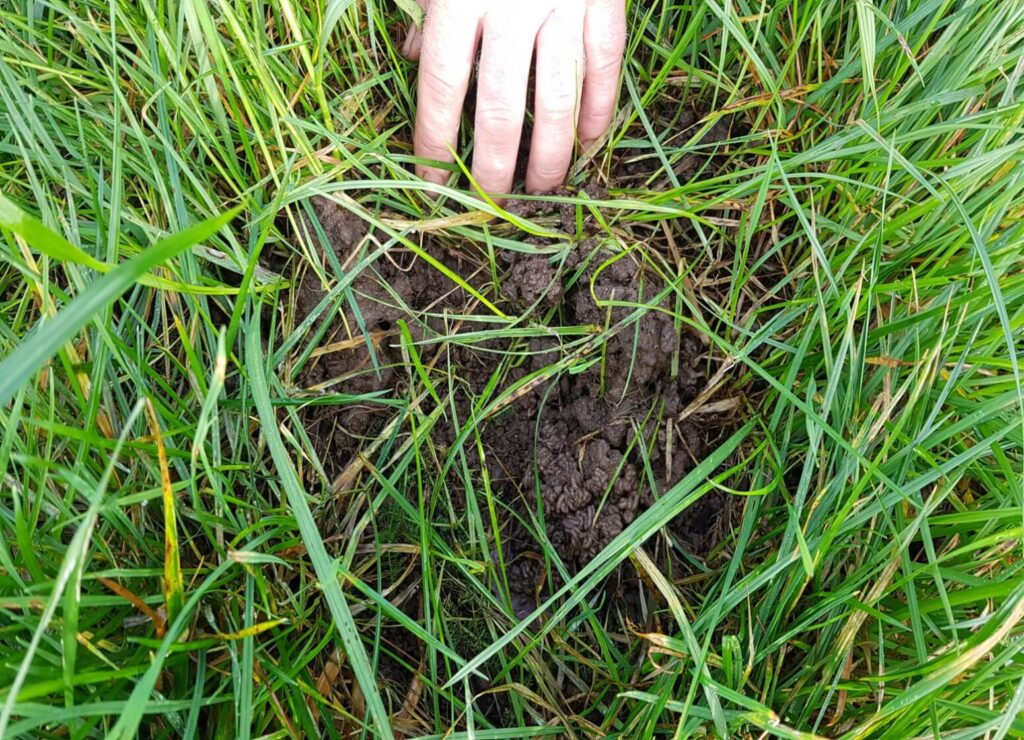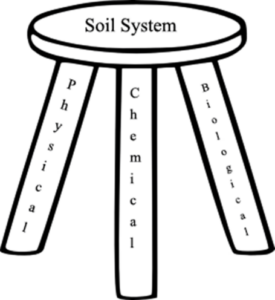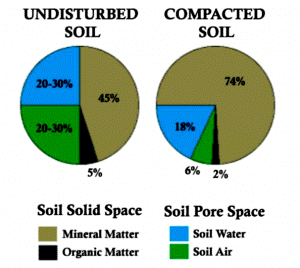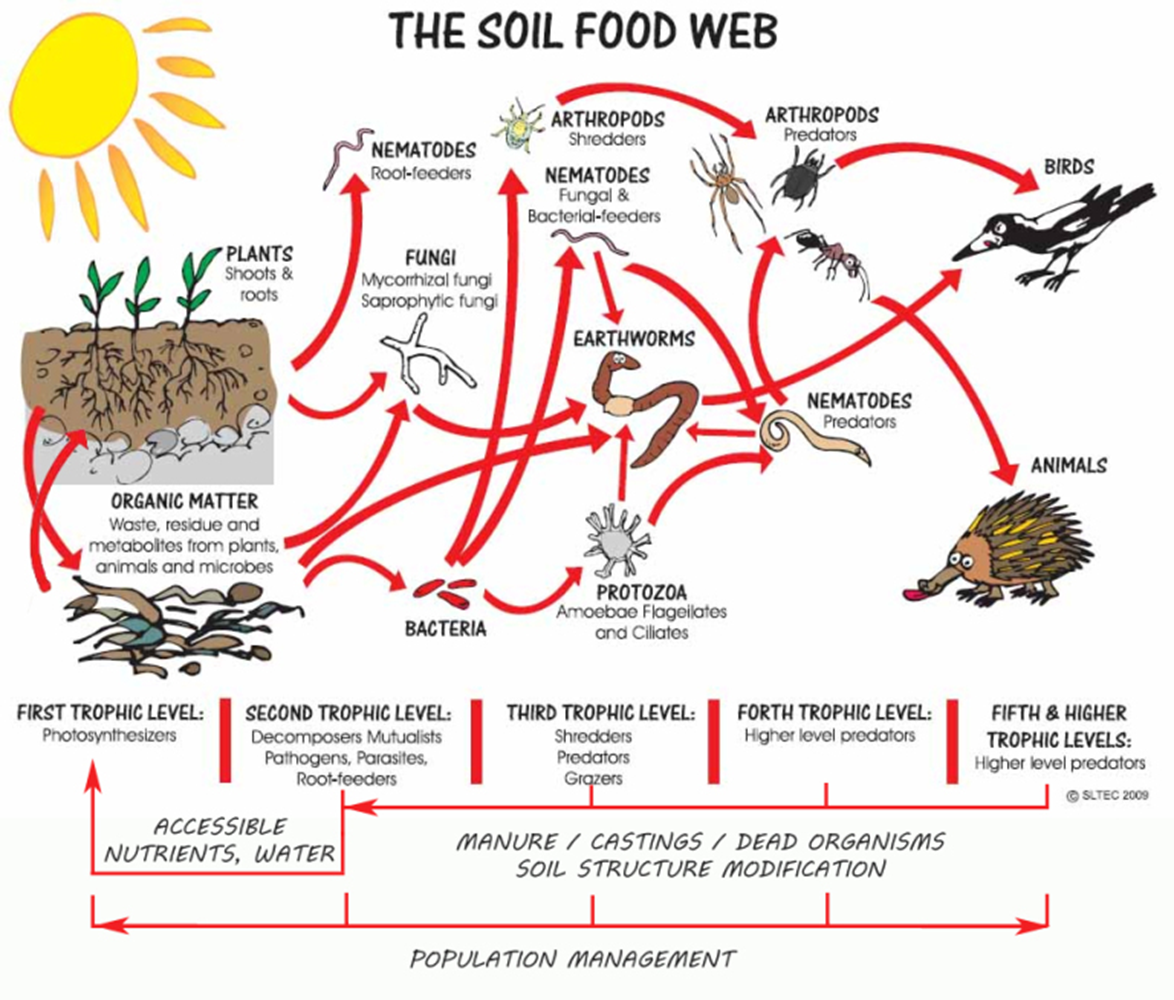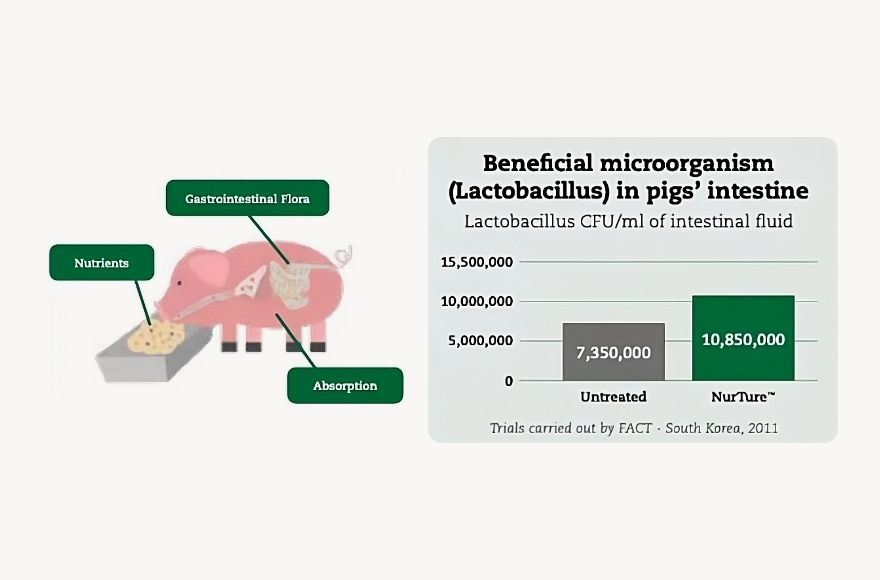Soil health is a term we hear a lot of recently but what is it?
Soil health is defined as the continued capacity of soil to function as a vital living ecosystem that sustains plants, animals, and humans ( www.nrcs.usda.gov, 2020)
When we look at a soil and want to assess how healthy it is, we have to consider three aspects: its’ physical, chemical and biological status. Analogous to a three-legged stool, each leg is influenced by the others and any leg can only partially compensate for a weakness in another.
To release the full potential of our soils we have to focus on and optimise all three aspects.
Chemical Aspect:
Modern soil chemistry is dominated by NPK fertilisers with soil chemistry testing dominated by the simplistic soil pH, buffer pH and Morgan’s P and K testing. Yes, it is important to keep things simple but oversimplicity has resulted in a lack of awareness/information as to the full potential of soils from a chemical viewpoint. A standard morgans soil test only shows the amount of P & K in the soil solution fraction that is readily available for uptake through the plant roots. These standard tests fail to show the amount of nutrients that are present in our soils in a form that is not readily available but can over time, with changes in management and inputs, become available. We advocate each farmer we work with to undertake some comprehensive soil testing which will help:
- Pinpoint major deficiencies that impacts production and soil health
- Assess levels of cations such as calcium and magnesium to ensure any inputs applied (e.g. dairy sludge*) does not create an imbalance and affect soil structure.
- Accurately measure the reserves of nutrients stored in our soils and help create a roadmap to release these over time
Table 1. P, K and S levels (available and reserves) on a Co. Cork dairy farm in 2017
As an example see Table 1 which mirrors to a large extent what we see on test results across the country. Comprehensive soil tests on this farm showed reserves of P and S sufficient for 40 years’ worth of production. K levels were high in available form but with low reserves – lower than seen in other parts of Ireland and much lower again than seen in the UK. It is even more important therefore on this farm to recycle as much K as possible through slurry, manure from grazing and also with purchased fertiliser. The high level of stored P has allowed this farmer to implement changes in his inputs and apply biological inputs that reduce his requirement for purchased P fertiliser to a minimum.
Physical Aspect:
When assessing the physical nature of a soil we look at:
- Smell – should smell earthy; no foul or putrid smells
- Aggregation – Soil aggregates are groups of soil particles that bind to each other more strongly than to adjacent particles. Soil aggregates are microhabitats for microorganisms and the space between the aggregates provide pore space for retention and exchange of air and water.
- Porosity – describes the pores, cracks, gaps and spaces both within and between the aggregates
- Structure – what the soil “architecture” is like. It describes how soil aggregates fit together and the amount of pore space between and within aggregates
- Texture – proportion of sand, silt and clay that make up the soil
Friable Soil (www.sruc.ac.uk, 2020)
A well-structured soil will have roughly 25% water, 25% air, 45% mineral matter and 5% organic matter. Pictured above are two examples of well-structured friable soils – aggregates are small and generally round and crumble easily between one’s fingers. The soil is highly porous with roots throughout the soil. Compare this to the compacted soil pictured below where aggregates are large, angular with poor porosity and a marked absence of roots.
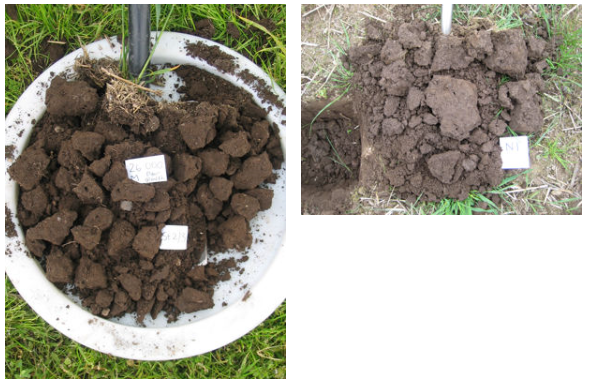 Compact Soil (www.sruc.ac.uk, 2020)
Compact Soil (www.sruc.ac.uk, 2020)
With high rainfall and current management practises, Irish soils, particularly in permanent grassland suffer a considerable amount of compaction with air space being literally squeezed out of the soil (see in figure to the right below).
(www.blogs.cornell.edu, 2020)
Root growth normally takes place in the air spaces around soil particles and compact soils thereby limit root penetration which in turn limits nutrient and water uptake. Long term soil compaction has led to an increasing level of iron and other metals accumulating in our top soil with implications for soil, plant and animal health. Compact soils are slower to dry after prolonged wet weather, less productive but also more prone to drought. The good news is we can help to remedy compact soils as part on an overall soil health program.
Biological Aspect:
The biological aspect of soils has rarely been spoke of up until the past few years but is an aspect of soils that we have sorely neglected. Biodiversity is a word we often hear to describe what is happening above ground with insects, birds etc but biodiversity in our soils is key to soil health and function. Pictured below, the soil food web (www.flickr.com) as it is known, shows the wide diversity of “soil livestock” that are involved in biological activity beneath our feet. These soil livestock range from the bacteria and fungi that fix nitrogen and release stored reserves of nutrients to the humble earthworm that burrows through the soil creating channels for water percolation, mixing and inoculating the soil particles that they consume. Amongst their many functions are to:
- make nutrients available without leaching
- rebuild damaged soil structure
- suppress disease causing organisms
- regulate water holding capacity
An acre of healthy topsoil can contain a web of life that includes:
- 500 Kg of earthworms
- 1,250 Kg of fungi
- 750 Kg of bacteria
- 65 Kg of protozoa
- 450 Kg of arthropods and algae
This plethora of soil organisms equates to billions of miniature bags of fertility, each storing nutrients in its body tissue while slowly converting them into plant-available forms.
Studies in England have shown that in healthy soil, forty tons of castings per acre pass through earthworms’ bodies each year. They are estimated to consume 4 – 10% of the top 6 inches of the soil annually. Earthworms are the first and most easily identifiable sign of a health soil. A healthy soil will have 20 mature and immature worms per spade. If less than 5 worms per spade soil biology is poor.
Functions of earthworms include:
- Shred organic matter & move it through soil
- Aerate soil & aggregate particles
- Increase & disperse microbes & nutrients throughout the soil
The castings (worm poo) that worms leave behind are:
- 50% higher in organic matter
- up to 7 times higher in available P
- up to 10 times higher in available K
- up to 5 times higher in available N
- up to 3 times higher in usable Mg
- 1.5 times higher in available Ca
Worms can eat their own weight each day and survive at a pH of 5 but thrive at pH of 6.5 – 7. It is important therefore to ensure we do all we can to help the humble earthworm survive and thrive and bring our soils to an optimum state of soil health.
Earthworm castings in permanent grassland (Dairy Farm, Co. Cork. January 2019)
Earthworm Castings in permanent grassland (Dairy Farm, Co. Cork. January 2019)
As with all livestock, their health and performance depend to a large degree on how they are fed and managed. Our “soil livestock” are no different and in many ways are similar to the rumen of a cow and rumen “bugs”. They like to be fed little and often with healthy balanced feed that they can digest and assimilate. Our ancestors understood this when FYM was left to cure outside over a 2 year period before been applied to the land – they knew that fresh FYM was detrimental to the soil. What we feed our soil livestock will dictate the health of our soils and small changes in management practises can yield significant changes in soil health over a 2 – 3 year period. Simple cost-effective steps like biologically treating all slurry and FYM applied can yield big dividends in soil health.
In summary, to understand soils we have to consider all three aspects of soils – the chemical, physical and biological with the knowledge that they are interlinked and require each to be fully functioning to optimise soil health. For example, a shortage of calcium (chemical aspect) can lead to a lower pH but can also lead to a tighter more compact soil (physical aspect). This is turn could lead to lower earthworm numbers and a lack of air in the soil for aerobic bacteria to carry out their function of releasing stored reserves of nutrients (biological aspect). An element lacking on the chemical side has a negative effect on the physical and biological aspect of a soil. The number of permutations like these and interactions between these three aspects of soil health are incalculable. But an understanding on how they rely on each other can help us build healthy resilient soils and release their full potential.
Sources:
Pasture Soil Compaction: Prevention and Remediation. https://blogs.cornell.edu/scnydairyandfieldcrops/2019/09/09/pasture-soil-compaction-prevention-and-remediation/ (accessed April 8th 2020)
The Soil Food Web. https://www.flickr.com/photos/salamanderspringsfarm/8579581486 (Accessed April 8th 2020)
Soil Health, NRCS Soils. https://www.nrcs.usda.gov/wps/portal/nrcs/main/soils/health/ (Accessed April 8th 2020)
Visual evaluation of soil structure. https://www.sruc.ac.uk/info/120625/visual_evaluation_of_soil_structure (Accessed April 8th 2020)
